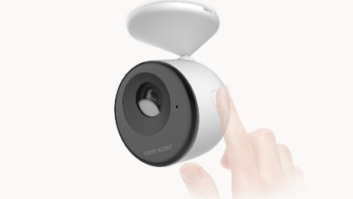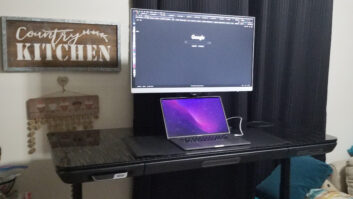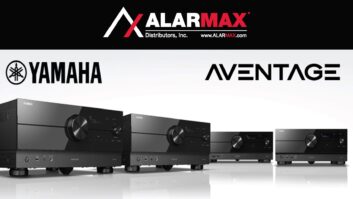Peabody, Mass. — The Horizon series of in-room molded-cabinet satellite speakers from Boston Acoustics includes three two-way bookshelf speakers at a suggested $99 to $150 each, a two-way LCR at $249 each and two two-way floorstanding speakers at $300 and $400 each.
The series also includes two six-piece home theater speaker packages with wired subwoofers and the TVee Model Two two-channel soundbar, which is packaged with a wireless subwoofer.
All of the satellite speakers, including those in the speaker packages, feature curved front baffles covered entirely by their grilles.
All of the satellite enclosures, including four Horizon subwoofers, are available in two finishes: mist (whitish) and midnight (blackish). A silver grille is standard with the mist enclosure, and an onyx grille is standard with the midnight enclosures. Grilles in optional colors will be available at a tentative $15 each. Eight colors are due at launch, with about another eight due in the first quarter.
Four subwoofers in the series, including a wireless model, are available in the same enclosure colors and also feature optional grille colors, but the enclosures are built from medium density fiberboard (MDF).
The three bookshelf models feature 1-inch soft-dome tweeter, and their woofers are 4 inches, 5 inches and 6 inches in diameter, respectively, and all enclosures are ported. A built-in wall bracket is designed to keep the rear-firing port off the wall. The LCR features two 5-inch woofers and a 1-inch tweeter.
The floorstanding speakers incorporate an integrated carrying handle for easy lifting when they have to be moved. One model incorporates one 1-inch tweeter, two 5.5-inch woofers, and two 6.6-inch passive radiators on the front panel. The step-up model features two 6.5-inch woofers and two 7-inch passive radiators.
In subwoofers, the HPS8WI is bundled with a 2.4GHz-band analog wireless transmitter to send bass signals from a user’s receiver or preamp/processor to an 8-inch 150-watt subwoofer. The other three subwoofers are wired model ranging in size from 10- to 12-inches and outputs from 150 watts to 300 watts at suggested retails of $299, $399 and $499.
The two six-piece speaker packages feature wired subwoofers. The $499 MCS100 package is equipped with four two-way satellites, each with 3-inch midbass driver and 0.75-inch tweeter. A center channel features dual 3-inch midbass drivers flanking a 0.75-inch tweeter. A 100-watt 8-inch subwoofer is included.
The $799 MCS130 packages includes three two-way LCR speakers with 1-inch tweeters and 3.5-inch midbass drivers. Also included are two surrounds and a 10-inch 200-watt powered sub.
In its TVee series, the TVee Model Two TV-accessory speaker at $399 features two tweeters and two woofers powered by a 2×25-watt amplifier. Its grille is also available in optional colors. A 50-watt wireless 2.4GHz powered subwoofer is included, but a dedicated remote isn’t because the sound bar learns the command codes of a user’s existing remote. Though it doesn’t feature virtual-surround technology like many other soundbars, “most solutions like this are much more expensive and less simple,” said sales and marketing VP Phil Cohn.
Also new: the $99-each SoundWare two-way cube speaker incorporates 0.75-inch tweeter and 4.5-inch woofer for response down to 90Hz. It comes with two brackets for wall- or corner-mounting. On the wall, they can be aimed to fire up or down at an angle toward the listening area. Their shape also enables them to be placed flat on a shelf.
The cabinets can be painted and also available in seven colors. They are weather-resistant, so they can be placed outdoors or in a bathroom.
When the Horizon series tabletop radios are unveiled in January, neither they nor the Vista series tabletop radios will incorporate HD Radio, the company said. Boston stopped production of its tabletop HD Radio because it “didn’t pull through the way we hoped for,” said engineering VP Dan Anagnos. The company has no plans for future HD Radios because it wants to focus its resources, he continued. Anagnos also noted that “iBiquity’s subsidies go away after a certain volume.”













